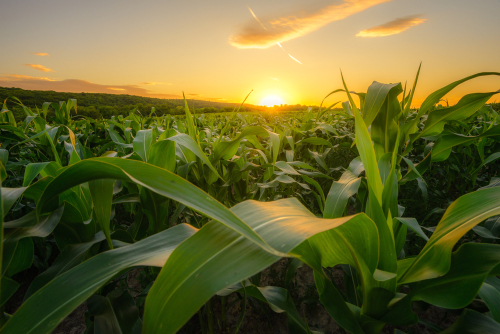
Asset Allocation | Commodities

Asset Allocation | Commodities
Across the broad macro landscape, investors are looking further afield into alternative assets, beyond the traditional public and private markets, to diversify their portfolios. This is especially true in the current environment of economic and geopolitical uncertainty. Farmland is one of the alternative assets that some investors have considered as a worthwhile addition to investment portfolios.
Although farmland is not front-and-centre in the general macro conversation, high-profile market names have talked about it for years. Regular followers of Warren Buffett will know of his enthusiasm for farmland. At the Berkshire Hathaway shareholder meeting in 2007, the ‘Oracle of Omaha’ spoke favourably about farmland, using its price as a way of differentiating between risk and volatility.
Earlier this year, Buffett told Berkshire Hathaway shareholders how he preferred farmland over bitcoin, extolling the virtues of the real asset over its digital counterpart. Moreover, Buffett and fellow billionaire Bill Gates both have farmland in their investment portfolios. In fact, Gates is the biggest private farmland owner in the US.
Farmland prices have risen sharply, as private equity and pension funds (among others) have been investing in farmland. In the US, prices have shot up nationwide by 12.4% from 2021 to 2022. The amount of land available for purchase is minimal, with less than 1% of farmland sold on the open market annually.
The US Department of Agriculture (USDA) released its Land Values 2022 Summary in August, showing that the average farm real estate value increased from $2,170 per acre in 2008 to $3,800 per acre in 2022, an increase of 75% (Chart 1). Roughly 40% of that aggregate increase, or $640 per acre, has occurred over the past two years.

In September, Bilal Hafeez spoke to Artem Milinchuk, Founder of FarmTogether, a farmland investing platform. In this podcast, Bilal and Artem discussed a wide range of themes in farmland investing.
Artem told Bilal that, in the United States, farmland is about a $3 trillion market with two broad categories: cropland and pastureland. The former includes annual crops (e.g., corn, soybeans) and permanent crops (e.g., tree nuts, fruits), while the latter is where livestock is grazed. There are also other fringe farms, including horticulture, dairy farms, fish farms and oyster farms. When the term farmland is used, it is cropland and pastureland that are salient. Cropland is by far the bigger category, which Artem estimates has a value of $2.1 trillion.
Like real estate, farmland has two income streams. First is the value of the land itself (which Artem says has grown by ~5.9% annually in the US in the past 50 years). And second is the current income, which is the income received from the crop grown on the land, harvested, and sold that year. There are various ownership/operating models in the farming industry, with 40% of the land in the US rented by farmers operating for owners.
In terms of current income, Artem says the annual return is ca. 5%. Going forward, Artem estimates that returns will be lower than before, given the current rich valuations for farmland. In the coming years, price appreciation plus current income should provide annual returns between 6% and 10% annually.
Comparing farmland to real estate in the US, Artem noted that Real Estate Investment Trusts (REITs) outperformed farmland over the past three years or so, although the volatility levels for residential real estate are higher than farmland. Artem told Bilal that in a broader sense, the correlation of farmland to other major asset classes has been zero to negative. Artem added that during the pandemic, the anecdotal evidence is that residential real estate values in cities like New York and San Francisco plummeted because of Covid, while the price of farmland remained steady.
The inflation pressures that have impacted every industry have also impacted farmland, with the cost of fertiliser, steel, and other inputs rising, leading to higher crop and land prices.
In the podcast, Bilal suggested that farmland should intuitively be an effective inflation hedge, which Artem confirmed. He said that during periods of high inflation in the 20th century, US farmland outperformed the S&P 500 by over 30%, and that farmland returns have historically exceeded inflation.
Breaking down the reasoning for farmland being an effective inflation hedge, Artem said that because farmland is limited in supply (and shrinking due to factors such as development, climate change, and urbanisation), it will naturally increase in price in inflationary environments. Also, because so much of the CPI measurements are embedded within the farming industry (e.g., farm feed, fuel, fibre), it makes sense that farmland is mechanically linked to CPI.
A rising interest rate environment is detrimental to farmland valuations. Artem likened farmland to a long duration bond, and that the longer the duration of the bond the higher the sensitivity is to interest rates. The current tightening path for the Fed and other central banks will be a drag on farmland valuations. Artem added, however, that the debt-to-active ratio for farmland is at 13%, compared to real estate which is often 50%-90%, and the S&P 500 which is 50%. Relative to these other asset classes, Artem contends that farmland is relatively under-leveraged.
As the push in recent years has intensified towards alternative assets to supplement returns generated from the traditional assets, farmland has emerged as a source of diversified investment return. The interest in farmland is particularly acute in inflationary times, as we are now experiencing. Farmland valuations have risen considerably recently and, as with any alternative asset, caution and prudence are de rigeur for any potential investor. Nonetheless, as an asset not featuring as prominently in the macro discourse as others, farmland will probably continue to rise in profile as an alternative asset.
Spring sale - Prime Membership only £3 for 3 months! Get trade ideas and macro insights now
Your subscription has been successfully canceled.
Discount Applied - Your subscription has now updated with Coupon and from next payment Discount will be applied.